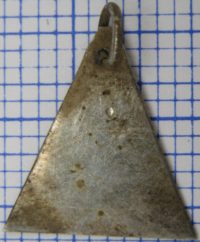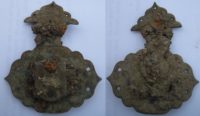 Archaeologists have discovered a small but exceedingly rare artifact during this season’s excavation of the 18th century fur trading settlement and colonial fort of Michilimackinac in Michigan’s lower peninsula. It’s a simple silver triangle pierced at the top with a tiny hoop, likely worn as a pendant or earring. It dates to around 1765 and was unearthed in the remains of a fur trader’s house. These modest pieces were trade silver, used as currency in the trading outposts of the colonies.
Archaeologists have discovered a small but exceedingly rare artifact during this season’s excavation of the 18th century fur trading settlement and colonial fort of Michilimackinac in Michigan’s lower peninsula. It’s a simple silver triangle pierced at the top with a tiny hoop, likely worn as a pendant or earring. It dates to around 1765 and was unearthed in the remains of a fur trader’s house. These modest pieces were trade silver, used as currency in the trading outposts of the colonies.
Trade silver is an excellent marker for the British era of the fur trade. The piece would have likely been used to trade for furs and pelts, Evans said.
She and her team found a smaller piece of trade silver several years ago, but it’s a pretty rare find
“We don’t find a lot of it at Fort Michilimackinac,” she said. “We were really excited.
They don’t find a lot of complete artifacts of any kind at Fort Michilimackinac. Active every summer since 1959, the excavation of Michilimackinac is the longest ongoing archaeological dig in the United States. Over the decades, archaeologists have recovered more than one million archaeological materials, but because the soldiers and traders left Fort Michilimackinac for Mackinac Island gradually over the course of two years, they had plenty of time to ensure nothing useful, valuable and intact was left behind. The vast majority of the items unearthed at the fort are refuse like broken glass, animal bones or lost or discarded items of little to no value like beads and buttons. That’s why it was major headline news when the 2015 dig recovered an intact ivory rosary from the home of a mid-18th century French fur trader.
 This season has been even more of a banner year, with two intact artifacts discovered: the trade silver pendant and last month, a brass lock that once sealed a small chest or box. Unearthed in the root cellar of the same fur trader’s home where the trade silver was found, the lock is 2.75″ long and 2.25″ wide at the widest part of its belly. It dates to between 1760 and 1770 and is an unusually decorative, fancy little fixture.
This season has been even more of a banner year, with two intact artifacts discovered: the trade silver pendant and last month, a brass lock that once sealed a small chest or box. Unearthed in the root cellar of the same fur trader’s home where the trade silver was found, the lock is 2.75″ long and 2.25″ wide at the widest part of its belly. It dates to between 1760 and 1770 and is an unusually decorative, fancy little fixture.
The house itself is older than both objects, having been built around 1730. Rubble on the site indicates the house was demolished in 1781 when the garrison and the traders completed their move to the island. During the 50 years it was standing, it was a bustling part of the trader community. Other items found in the interior of the house underscore that it once belonged to fur traders, something the team knew from the beginning of the dig but was confirmed by the discoveries. Archaeologists unearthed more than a dozen  gunflints, four musket balls of trade gun caliber, fishhooks, Jesuit ring fragments and a variety of glass trade beads in a selection of colors and sizes.
gunflints, four musket balls of trade gun caliber, fishhooks, Jesuit ring fragments and a variety of glass trade beads in a selection of colors and sizes.
The site will continue to be excavated until the season ends in August. Until then, visitors to Colonial Michilimackinac, the open-air museum on the site of the site of the 18th century fort and trading village that is now part of the Mackinac State Historic Parks system, can view the archaeologists in the trenches, ask them about their work, see finds as they come out of the ground.
A number of the few surviving Native-American muskets in the Old Northwest, from the mid-18th to early 19th cen., where the fort was located, are often ornately decorated with trade silver. Those Great Lakes forts were one stop shopping for the local Natives.
The Hudson’s Bay Company outposts and the British lake forts must have been the Wal-Mart’s of their time.
Is there any way of following this blog?
Keith.